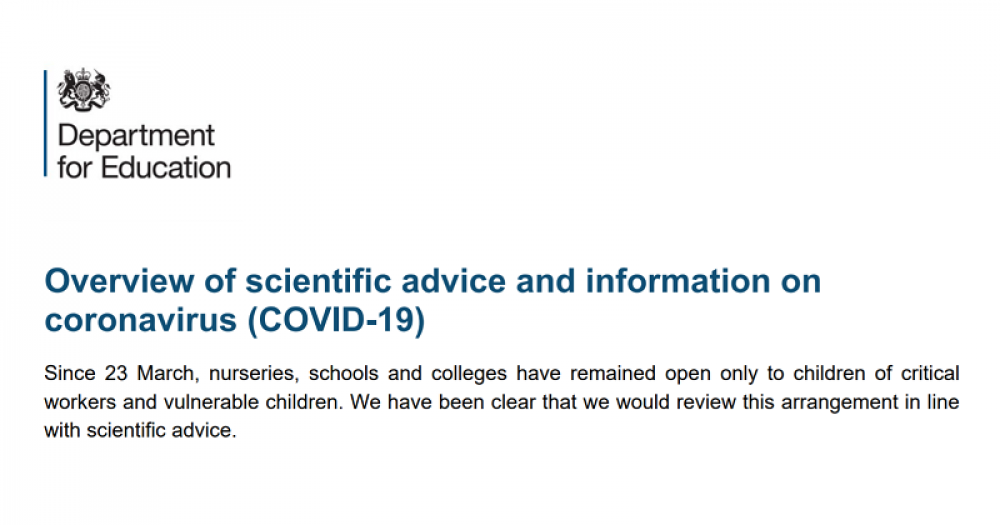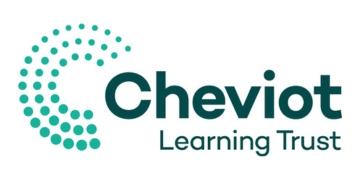The Department for Education has finally published an overview of the scientific advice it has received.
The document, released today, summarises advice from the government’s Scientific Advisory Group for Emergencies (SAGE) and its Children’s Task and Finish Working Group.
However, it does not include evidence from SAGE or the sub-group, which is being published separately.
It follows repeated calls from school leaders, union bosses and opposition politicians since the government announced it wanted to begin the phased opening of schools on June 1.
The document states that the “exact rates of infectivity and transmission of children is not fully known yet”, and that because this is a “novel virus”, the scientific understanding is “developing all the time”.
However, the document states that the “current understanding” is that there is a “high degree of confidence” that the severity of disease in children is lower than in adults.
There is also a “moderate to high degree of confidence” that the susceptibility to clinical disease of younger children (up to age 11 to 13) is lower than for adults. But for older children, there is” not enough evidence yet to determine whether susceptibility to disease is different to adults”.
“The susceptibility to infection of younger children (up to age 11 to 13) might be lower than for adults, but the degree of confidence in this is low. For older children there is not enough evidence yet to determine whether susceptibility to infection is different to adults.”
There is also “no evidence to suggest that children transmit the virus any more than adults”, the document states.
“Some studies suggest younger children may transmit less, but this evidence is mixed and provides a low degree of confidence at best.
Meanwhile, the document also reveals that social distancing has not been factored into the models considered by SAGE. It repeats earlier DfE guidance admitting that young children cannot be expected to observe social distancing measures of remaining two metres apart.
Instead, a “hierarchy of controls” will create an “inherently safer system, where the risk of transmission of infection is substantially reduced”, the document claims.
These measures include cleaning hands more often, cleaning frequently touched surfaces and minimising contact and mixing of people.
The document also states that schools should be “especially sensitive to the needs and worries of BAME members of staff, BAME parents and BAME pupils”.
It states: “The exact reasons for the increased risk associated with coronavirus (COVID-19) in BAME populations are not known, and there are a number of factors that could underlie this.”
Errors suggest document was rushed out
Bizarrely, under the heading ‘spread and vulnerability to disease’, the document also contains erroneous text which talks about “testing subjects”.
A search of DfE documents shows this line is actually from a 2014 key stage 4 science consultation.
One passage of the document states that “in the event of a child or member of staff testing positive for coronavirus (COVID-19), the relevant group of people within the school with whom the child has mixed closely (their cohort), should be sent home and advised to self-isolate for 7 days”.
However, a later paragraph states that in the same situation, they should be sent home and advised to self isolate for 14 days.
Update: The Department has replaced the document, removing the erroneous text. However, the conflicting statements over the period of isolation remain.








So, in short children don’t, in general, suffer severe illnesses from the virus, they’re very likely to be asymptomatic, and they could transmit the virus at the same rate as adults.
I think the DfE are going to have to draw pictures to explain to me why I wouldn’t need PPE in a situation where I would be in close contact with people who can’t, by the DfEs own admission, socially distance.
What other job sector is this rationale being applied to?!
Also why does the DFE guidance constantly refer to only needing PPE when children are ‘symptomatic’. What about if they are asymptomatic, I’m not psychic!
To answer your question, this kind of thinking may have been applied to care workers. Noting the assertion that “teachers aren’t as likely to become infected as easily ” exposes the irrational thinking and failure to recall that the profession is more elderly especially so because many can’t afford to retire particularly the WASPI women.
The BBC has just reported that the BMA is’ “completely aligned” with teachers’ union calls to delay reopening.’
“Until we have got case numbers much lower, we should not consider reopening schools,” said a letter from the BMA’s council chair.
https://www.bbc.co.uk/news/education-52669441
Exactly. Meantime we must take significant and swift actions to support learning, students and parents. We need to differentiate between primary and secondary students: we teach them in different ways and there is some reliable evidence from South Korea that adolescents are five times more likely to be carrying the virus than younger children. Older students need us to create The Open School, a schools version of the OU run through schools and the parents of younger need more support.
Until deaths lower we shouldn’t return. Until more research is done and confidence gained we should not return. Until the restrictions society are being asked to abide by (PPE in crowds and social distancing) are inline with what schools are being advised to do we should not go back.
When the house of commons is full of MPs again, maybe I’ll consider it being safe for children to return to a school setting. As a mother of 2 teachers I find it horrendous that my children are expected to teach in these conditions without any PPE
I feel it is far too early for children to return to school. I believe the risk to adults has not been addressed properly and the advice that staff do not need ppe could be putting our lives at risk needlessly.
If children are deemed to be a risk to their own families then can somebody please explain to me why there is no risk to the school staff and within peer groups. Why can we not use our common sense and children return in September to their current classrooms for 6 weeks to ensure continuity from what they know and are familiar with and to allow staff to create a smooth transition.
No one has actually mentioned the Kawasaki…Covid 19 virus found in Children….12 in icu and 1 death…..
This whole situation is being driven by our Economy….nothing else…..
unless a vaccine is developed this disease will be with us indefinitely why have the unions and parent groups been excluded from having their voices heard as a grandparent who is being shielded until june when I am allowed to come into contact with the grandchildren to then be given the virus by said children.. if the children cannot visit grandparents they cannot attend school some grandparents take them and collect them whilst parents work
I agree to the above comments entirely. Staff and children are not been fully protected even now. Schools and nurseries are open for key workers and vulnerable children which is definately necessary but neither child or staff are been protected. Nursery children would never relate to social distancing they need comfort and made to feel safe so every day staff are putting themselves at risk. This should have been sorted out with thorough risk assessment and staff given PPE to protect themselves which in turn will protect the child. This is as sinful as the elderly for been discharged to a care home not been tested for covid. Let’s pray the consequences are not as catastrophic.
I believe that most teachers, school staff & Teachers’ Unions ALWAYS want the very best for children / pupils.
The letter sent to Gavin Williams regarding 5 points that should be in place before schools are re- opened (in approx . 2 weeks time) are not just sensible but medically / scientifically extremely apprpriate to safeguard children & staff. But not yet answered.
To test teachers & school staff IN June ………will presumably be AFTER teachers & staff are already in school with children & others ?
There are still many key workers with no testing or tracking.
And no mention has been made about teachers or children who are more medically vulnerable eg diabetic or live with family who are.
No mention has been made by the government about clarification of children with what doctors fear is COVID related ….severe cases of ‘ syndromes’ in hospitalised children, ‘ A new emerging risk to children’.
GPs have been sent details of what to look for in children.
Gavin Williamson & Boris Johnson keep quoting the example of Denmark but one has to be very careful with comparisons….
Denmark has a population of 5,421241….337 deaths ……20 seriously ill
Uk ………………………………………………..67, 886,011…..33, 998 deaths..1559 ”
And other demographics are very different.
The comment of keeping the children in a ‘ protective’ bubble appears to be mostly ‘ spacing’ , frequent hand washing, ‘ cleaning’ surfaces ( but not use of the word ‘ decontaminating’), taking their own lunch box to school but not their own pencil case ……and what else???
The BMA has supported the NEU over its concerns that it is too soon. Spain & Italy are
re- opening schools in September.
Most teachers have done their utmost to teach & support children online since March & it has been extremely stressful & difficult.
The government are very keen to get schools re – opened & have spoken to the
Teachers’ Unions but apparently not very many teachers , who are going to be in the classrooms. Teachers voices need to be heard not just those to date.
I have worked in nurseries for over 30 years and common sense tells me that sending babies and young children back to nurseries is going to be wrong. A young child will not understand why we’re not able to give them hugs when they are upset, not feeling well ect, why they can’t get close to each other share toys, play on the same things, hold hold hands . So much has not been thought through and not enough time has been given to planning this will work. As usual the experts have not been consulted. It might look good on paper but not in practise.